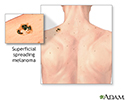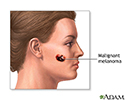Melanoma
Skin cancer - melanoma; Malignant melanoma; Lentigo maligna melanoma; Melanoma in situ; Superficial spreading melanoma; Nodular melanoma; Acral lentiginous melanomaMelanoma is the most dangerous type of skin cancer. It is also the rarest. It is the leading cause of death from skin disease. Other common types of skin cancer are squamous cell carcinoma and basal cell carcinoma.
The Basics
Tests for skin cancer - malignant melanoma
Melanoma - Animation
Melanoma
Animation
Skin cancer - malignant melanoma
Malignant melanoma. The incidence of this form of skin cancer is increasing faster than that of any other form of cancer.
Skin cancer - malignant melanoma
illustration
Skin cancer, melanoma on the fingernail
Malignant melanoma is the most dangerous type of skin cancer. Melanomas beneath the fingernail appear as a black or bluish black discoloration. This type of malignancy spreads (metastasizes) readily.
Skin cancer, melanoma on the fingernail
illustration
Skin cancer - melanoma superficial spreading
Malignant melanoma is the most dangerous type of the skin cancers. Typical features of melanomas include irregular borders, multiple colors within the lesion, rapid growth, and susceptibility to easy injury with bleeding. Any mole that exhibits any of these changes should be evaluated immediately by your health care provider.
Skin cancer - melanoma superficial spreading
illustration
Skin cancer - close-up of level III melanoma
Malignant melanoma is the most dangerous type of the skin cancers. Typical features of melanomas include irregular borders, multiple colors within the lesion, rapid growth, and susceptibility to easy injury with bleeding. Any mole that exhibits any of these changes should be evaluated immediately by your physician.
Skin cancer - close-up of level III melanoma
illustration
Melanoma
Melanoma is a malignant skin tumor that involves the skin cells that produce pigment (melanin). The risk of melanoma increases with age, but frequently effects young, otherwise healthy people. Melanoma is an aggressive type of cancer that can spread very rapidly.
Melanoma
illustration
Malignant melanoma
Melanoma is a malignant skin tumor that involves the skin cells that produce pigment (melanin). The risk of melanoma increases with age, but frequently affects young, otherwise healthy people. Melanoma is the number one cause of cancer death in women aged 25 to 30.
Malignant melanoma
illustration
Skin cancer - close-up of level IV melanoma
Malignant melanoma is the most dangerous type of the skin cancers. Typical features of melanomas include irregular borders, multiple colors within the lesion, rapid growth, and susceptibility to easy injury with bleeding. Any mole that exhibits any of these changes should be evaluated immediately by your physician.
Skin cancer - close-up of level IV melanoma
illustration
Skin cancer, close-up of lentigo maligna melanoma
Increased risk for skin cancer, especially melanoma, is associated with chronic exposure to sunlight, blistering sunburns, and a family history of skin cancer.
Skin cancer, close-up of lentigo maligna melanoma
illustration
Skin cancer - malignant melanoma
Malignant melanoma. The incidence of this form of skin cancer is increasing faster than that of any other form of cancer.
Skin cancer - malignant melanoma
illustration
Skin cancer, melanoma on the fingernail
Malignant melanoma is the most dangerous type of skin cancer. Melanomas beneath the fingernail appear as a black or bluish black discoloration. This type of malignancy spreads (metastasizes) readily.
Skin cancer, melanoma on the fingernail
illustration
Skin cancer - melanoma superficial spreading
Malignant melanoma is the most dangerous type of the skin cancers. Typical features of melanomas include irregular borders, multiple colors within the lesion, rapid growth, and susceptibility to easy injury with bleeding. Any mole that exhibits any of these changes should be evaluated immediately by your health care provider.
Skin cancer - melanoma superficial spreading
illustration
Skin cancer - close-up of level III melanoma
Malignant melanoma is the most dangerous type of the skin cancers. Typical features of melanomas include irregular borders, multiple colors within the lesion, rapid growth, and susceptibility to easy injury with bleeding. Any mole that exhibits any of these changes should be evaluated immediately by your physician.
Skin cancer - close-up of level III melanoma
illustration
Melanoma
Melanoma is a malignant skin tumor that involves the skin cells that produce pigment (melanin). The risk of melanoma increases with age, but frequently effects young, otherwise healthy people. Melanoma is an aggressive type of cancer that can spread very rapidly.
Melanoma
illustration
Malignant melanoma
Melanoma is a malignant skin tumor that involves the skin cells that produce pigment (melanin). The risk of melanoma increases with age, but frequently affects young, otherwise healthy people. Melanoma is the number one cause of cancer death in women aged 25 to 30.
Malignant melanoma
illustration
Skin cancer - close-up of level IV melanoma
Malignant melanoma is the most dangerous type of the skin cancers. Typical features of melanomas include irregular borders, multiple colors within the lesion, rapid growth, and susceptibility to easy injury with bleeding. Any mole that exhibits any of these changes should be evaluated immediately by your physician.
Skin cancer - close-up of level IV melanoma
illustration
Skin cancer, close-up of lentigo maligna melanoma
Increased risk for skin cancer, especially melanoma, is associated with chronic exposure to sunlight, blistering sunburns, and a family history of skin cancer.
Skin cancer, close-up of lentigo maligna melanoma
illustration
Melanoma
Skin cancer - melanoma; Malignant melanoma; Lentigo maligna melanoma; Melanoma in situ; Superficial spreading melanoma; Nodular melanoma; Acral lentiginous melanomaMelanoma is the most dangerous type of skin cancer. It is also the rarest. It is the leading cause of death from skin disease. Other common types of skin cancer are squamous cell carcinoma and basal cell carcinoma.
The Basics
Tests for skin cancer - malignant melanoma
Melanoma
Skin cancer - melanoma; Malignant melanoma; Lentigo maligna melanoma; Melanoma in situ; Superficial spreading melanoma; Nodular melanoma; Acral lentiginous melanomaMelanoma is the most dangerous type of skin cancer. It is also the rarest. It is the leading cause of death from skin disease. Other common types of skin cancer are squamous cell carcinoma and basal cell carcinoma.
The Basics
Tests for skin cancer - malignant melanoma
Review Date: 2/15/2024
Reviewed By: Elika Hoss, MD, Assistant Professor of Dermatology, Mayo Clinic, Scottsdale, AZ. Also reviewed by David C. Dugdale, MD, Medical Director, Brenda Conaway, Editorial Director, and the A.D.A.M. Editorial team.










